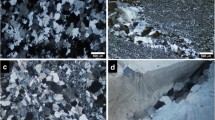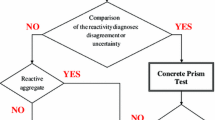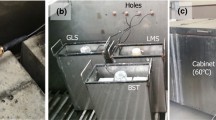Abstract
Deterioration of concrete due to alkali-silica reaction (ASR) involves a reaction between alkaline ions in the cement pore solution and non-crystalline silica found in many aggregates. Diagnosing and quantifying deterioration due to ASR in concrete currently requires destructive testing for microscopy examinations. In this paper, electrical conductivity is investigated qualitatively as an alternative non-destructive evaluation (NDE) method of ASR in hardened concrete. The study was performed using an unrestrained set of small concrete prism specimens made with highly reactive small aggregates, and kept in an environmental chamber according to ASTM C1293 standard. In a companion study, destructive petrography and damage rating index (DRI) assessment, and pore solution extraction and analysis were performed on the same set of accelerated ASR specimens. The results show that temporal evolution of nondestructive bulk resistivity is linearly correlated with destructive DRI score.











Similar content being viewed by others
References
Saouma VE, Hariri-Ardebili MA, Le Pape Y, Balaji R (2016) Effect of alkali–silica reaction on the shear strength of reinforced concrete structural members. A numerical and statistical study. Nucl Eng Des 310:295–310
Giaccio G, Zerbino R, Ponce JM, Batic R (2008) Mechanical behavior of concretes damage due to ASR. Cem Concr Res 38:993–1004
Ulm FJ, Cousy L, Larive C (2000) Thermo-chemo-mechanics of ASR expansion in concrete structures. J Eng Mech 126:233–242
Bazant ZP, Steffens A (2000) Mathematical model for kinetics of alkali-silica reaction in concrete. Cem Concr Res 30:419–428
Rajabipour F, Giannini E, Dunanat C, Ideker JH, Thomas MDA (2015) Alkali-silica reaction: Current understanding of the reaction mechanisms and the knowledge gaps. Cem Concr Res 76:130–146
Figueira RB, Sousa R, Coelho L, Azenha M, de Almeida JM, Jorge PAS, Silva CJR (2019) Alkali-silica reaction in concrete: mechanisms, mitigation and test methods. Constr Build Mater 222:903–931
ASTM C1260-07 (2007) Standard test method for potential alkali reactivity of aggregates (Mortar Bar Method). West Conshohocken, PA, USA, ASTM International
Multon S, Toutlemonde F (2006) Effect of applied stresses on alkali-silica reaction-induced expansions. Cem Concr Res 36:912–920
Alnaggar M, Cusatis G, Di Luzio G (2013) Lattice discrete particle modleing (LDPM) of alkali silica reaction (ASR) deterioration of concrete structures. Cem Conc Comp 41:45–59
Rivard P, Saint-Pierre F (2009) Assessing alkali-silica reaction damage to concrete with non-destructive methods: from the lab to the field. Constr Build Mater 23:902–909
Ju T, Achenbach JD, Jacobs LJ, Guimares M, Qu J (2017) Ultrasonic nondestructive evaluation of alkali-silica reaction in concrete prism samples. Mater Struct 50:60
Lesnicki KJ, Kim J-Y, Kurtis K, Jacobs L (2013) Assessment of alkali-silica reaction damage through quantification of concrete nonlinearity. Mater Struct 46:497–509
Donnel KM, Zoughi R, Kurtis KE (2013) Demonstration of microwave method for detection of alkali-silica reaction (ASR) gel in cement-based materials Cem Concr Res 44: 1–7
Hashemi A, Kurtis KE, Donnell KM, Zoughi R (2017) Empirical multiphase dielectric mixing model for cement-based materials containing alakali-silica reaction gel. IEEE Trans Instrum Meas 66:2428–2436
Rashidi M, Knapp MCL, Hashemi A, Kim J-Y, Donnell KM, Zoughi R, Jacobs LJ, Kurtis KE (2016) Detecting alkali-silica reaction: a multiphysics approach. Cem Concr Compos 73:123–135
Heifetz A, Strow M, Liu Y, Bevington P, Zapol P, Bakhtiari S, Bentivegna A (2020) Monitoring of dielectric permittivity in accelerated alkali-silica reaction concrete with microwave backscattering. Mater Struct 53:130
Heifetz A, Bakhtiari S, Lu J, Aranson IS, Vinokur VM, Bentivegna AF (2017) Development of microwave and impedance spectroscopy methods for in-situ nondestructive evaluation of alkali-silica reaction in concrete. AIP Conf Proc 1806:12003
Heifetz A, Bakhtiari S, Lu J, Bentivegna A (2017) Nondestructive evaluation of alkali-silica reaction in high-strength concrete for aging structure sustainability. Trans Am Nucl Soc 116:453–456
Bakhtiari S, Chien HT, Heifetz A, Elmer TW (2018) Nondestructive testing research and development efforts at Argonne National Laboratory: an overview. Mater Eval 76:911–920
Christensen BJ, Coverdale RT, Olson RA, Ford SJ, Garboczi EJ, Jennings HM, Mason TO (1994) Impedance spectroscopy of hydrating cement-based materials: measurement, interpretation and application. J Am Ceram Soc 77:2789–2804
Rajabipour F, Weiss J (2007) Electrical conductivity of drying cement paste. Mater Struct 40:1143–1160
Cabeza M, Keddam M, Nóvoa XR, Sánchez I, Tekenouti H (2006) Impedance spectroscopy to characterize the pore structure during the hardening process of Portland cement paste. Electrochim Acta 51:1831–1841
Bentz DP (2007) A virtual rapid chloride permeability test. Cem Concr Compos 29:723–731
Snyder KA, Feng X, Keen BD, Mason TO (2003) Estimating the electrical conductivity of cement pore solutions from OH-, K+ and Na+ concentrations. Cem Concr Res 33:793–798
ASTM C1293-08b (2008) Standard test method for determination of length change of concrete due to alkali-silica reaction. West Conshohocken, PA, USA, ASTM International
Rivard P, Ballivy G (2005) Assessment of the expansion related to alkali-silica reaction by the Damage Rating Index method. Constr Build Mater 19:83–90
Rivard P, Fournier B, Ballivy G (2002) The DRI method for ASR affected concrete: a critical review of petrographic features of deterioration and evaluation criteria. Cem Concr Aggr 24:1–10
Sanchez LMF, Drimalas T, Fournier B (2020) Assessing condition of concrete affected by internal swelling reactions through the Damage Rating Index (DRI). Cement 1–2: 100001
Dunbar P, Grattan-Bellew PE (1995) Results of damage rating evaluation of condition of concrete from a number of structures affected by ASR. In: Proceedings of the CANMET/ACI international workshop on alkali-aggregate reactions in concrete, Dartmouth, Canada
Grattan-Bellew PE, Mitchell LD (2006) Quantitative petrographic analysis of concrete: the damage rating index (DRI) method, a review. In: Proceedings of the Marc-Andre Berube symposium on AAR in Concrete, ANMET/ACI advances in concrete technology seminar, Montreal, Canada
ASTM C150/C150M-21 (2021) Standard specification for portland cement. West Conshohocken, PA, USA, ASTM International
ASTM Standard C294 (2017) Standard descriptive nomenclature for constituents of concrete aggregates. West Conshohocken, PA, ASTM International
ASTM C231 (2017). Standard test method for air content of freshly mixed concrete by the pressure method. West Conshohocken, PA, USA,
ASTM C192 (2016) Standard practice for making and curing concrete test specimens in the laboratory. West Conshohocken, PA, ASTM International
ASTM C157 (2017) Standard test method for length change of hardened hydraulic-cement mortar and concrete. West Conshohocken, PA, ASTM International
ASTM International ASTM C856-11 (2011) Standard practice for petrographic examination of hardened concrete. West Conshohocken, Pennsylvania, USA, ASTM International
Acknowledgements
Argonne National Laboratory’s work was supported by the Nuclear Energy Science and Technology Laboratory-Directed Research and Development (LDRD) program under contract DE-AC02-06CH11357.
Author information
Authors and Affiliations
Corresponding author
Ethics declarations
Conflict of interest
The authors declare that they have no conflict of interest.
Additional information
Publisher's Note
Springer Nature remains neutral with regard to jurisdictional claims in published maps and institutional affiliations.
Rights and permissions
About this article
Cite this article
Strow, M., Bevington, P., Bentivegna, A. et al. Monitoring accelerated alkali-silica reaction in concrete prisms with petrography and electrical conductivity measurements. Mater Struct 55, 119 (2022). https://doi.org/10.1617/s11527-022-01942-8
Received:
Accepted:
Published:
DOI: https://doi.org/10.1617/s11527-022-01942-8




